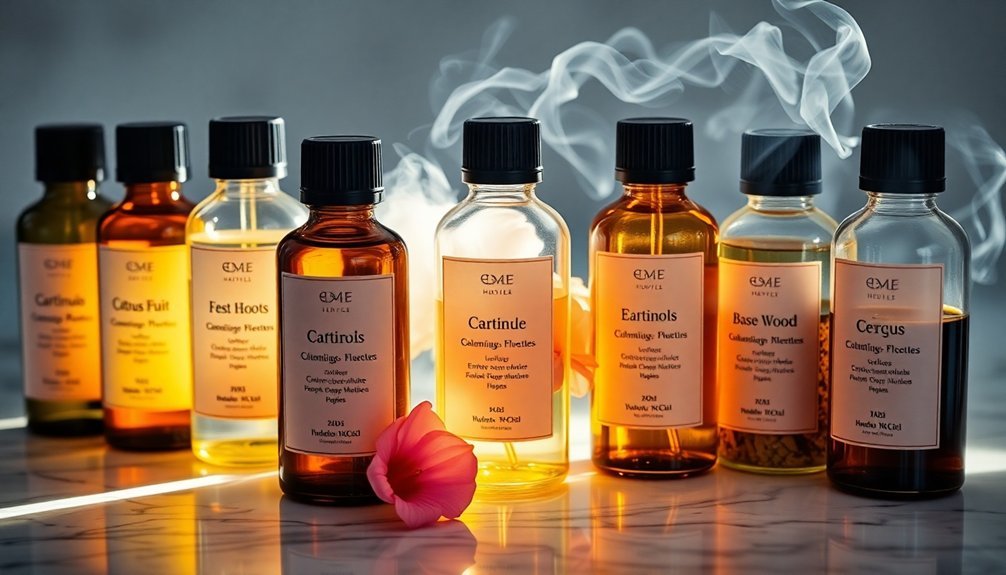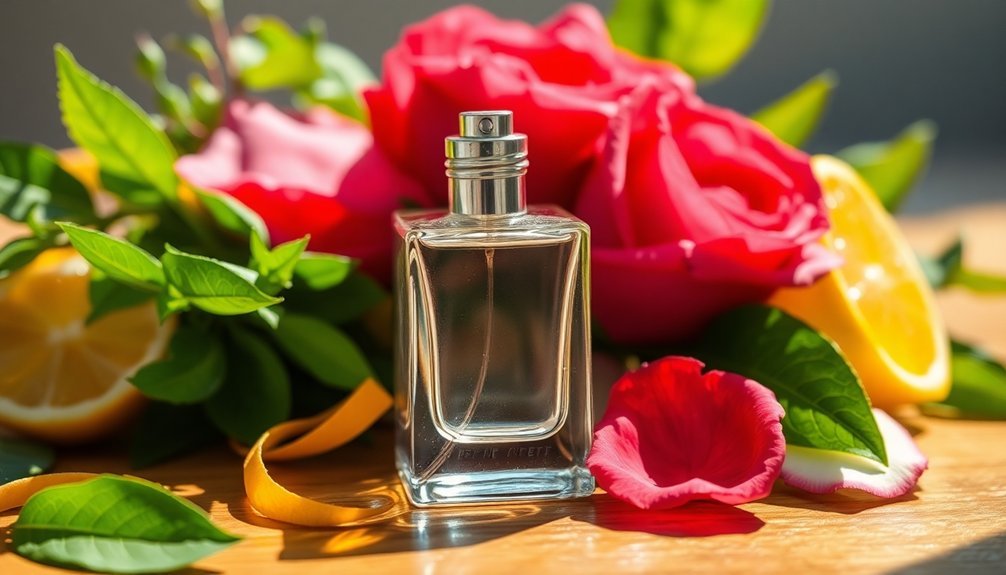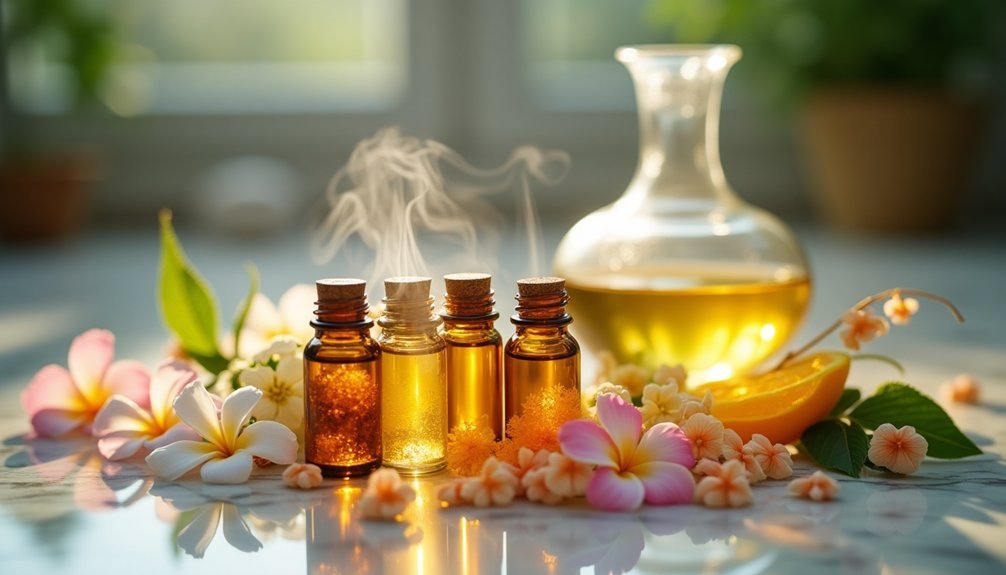Perfume notes blend harmoniously based on their molecular chemistry, cultural traditions, and psychological appeal. You'll find that certain scents naturally complement each other because of their similar evaporation rates and molecular structures. For example, fresh citrus notes pair well with light florals, while deep woody notes match the richness of oriental scents. Understanding these relationships through tools like the Perfume Wheel helps you create balanced, lasting fragrances. Discover how science and artistry unite to craft the perfect scent combination.
The Science Behind Fragrance Families

When you explore the world of perfumery, you'll discover that fragrances aren't just random combinations of scents. Since 1912, perfumes have been organized into seven distinct olfactory families: Citrus, Floral, Woody, Leathery, Oriental, Chypre, and Fougère.
The first four families are identified by their primary notes – like citrus oils that create fresh, light scents, or woody elements that deliver rich, lasting aromas. These families help interpret emotional messages through their distinct characteristics.
The remaining three families are based on specific accords, which are harmonious combinations of multiple notes. For instance, Fougère combines bergamot, lavender, and oakmoss to achieve its signature fresh-warm balance, while Oriental fragrances blend amber, musk, and vanilla for a rich, sweet profile.
Each family also contains subfamilies that offer more specific scent variations.
Understanding the Perfume Wheel
Building on these fragrance families, the Perfume Wheel offers a more visual and intuitive way to understand scent relationships. Created by Michael Edwards in 1983, this circular diagram organizes fragrances into four main categories: floral, oriental (now amber), woody, and fresh, with various subcategories branching from each.
The wheel serves as a standardized reference tool for both industry professionals and fragrance enthusiasts alike. You'll find the wheel especially useful when you're exploring new scents. By identifying a fragrance's prominent notes and locating them on the wheel, you can discover complementary scents by looking at opposite or adjacent sections.
For even more interesting combinations, try selecting fragrances that form a triangle on the wheel. This systematic approach, evolved from Paul Jellinek's 1949 Odor Effects Diagram, has become the industry standard for perfumers and enthusiasts to communicate and understand complex scent compositions.
Top, Heart, and Base Note Dynamics

The distinct evaporation rates of perfume molecules shape how you'll experience each phase of a fragrance, from the quick-fading top notes to the long-lasting base notes.
You'll notice this progressive development as lighter molecules evaporate first, revealing heavier compounds that remain on your skin longer. Heart notes emerge to provide depth and solidity during this progression.
The chemical structures of these notes work together to create harmony, with specific molecular combinations forming accords that enhance the overall fragrance experience.
Evaporation Rate Influences Performance
Understanding how perfume notes evaporate reveals why fragrances evolve throughout the day.
You'll notice top notes disappear within 30 minutes, while heart notes last several hours, and base notes can persist for days. This graduated evaporation creates a fragrance's unique journey on your skin.
Three key factors affect how your perfume performs:
- Molecular weight – lighter molecules in top notes evaporate quickly, while heavier base notes linger
- Environmental conditions – heat and light can accelerate evaporation across all notes
- Application technique – proper layering and storage help maintain the intended balance
When you understand these evaporation patterns, you can better appreciate why perfumers carefully blend notes to achieve harmony.
The interplay between volatile and stable compounds guarantees your fragrance shifts smoothly from first spray to final dry-down.
Chemical Structure Creates Harmony
Within every enchanting fragrance lies a carefully orchestrated symphony of chemical structures that create lasting harmony.
You'll notice the volatile top notes first, where molecules like limonene deliver bright citrus bursts that fade within minutes. These seamlessly shift into the heart notes, which form the fragrance's core melody and last for several hours. Here, you'll experience full-bodied florals and warm spices that make up 70% of the scent.
The base notes anchor everything together with long-lasting molecules like vanillin and coumarin. These deeper elements provide the foundation through woods and musks that persist on your skin.
When perfumers blend these notes, they're creating accords that guarantee each molecular component works in perfect balance, delivering a cohesive and sophisticated scent experience.
Natural vs. Synthetic Note Combinations
You'll notice distinct differences in how natural and synthetic perfume notes interact at the molecular level, with synthetic molecules typically offering greater stability and predictability.
Natural extracts bring intricate layers of complexity that can't be fully replicated in a lab, contributing unique characteristics to the overall fragrance profile.
When you're combining both types, you'll find that natural and synthetic notes blend differently with other ingredients, creating opportunities for innovative scent combinations while requiring careful attention to their unique behaviors.
Molecular Stability Differences
When comparing natural and synthetic perfume notes, their molecular stability reveals striking differences that directly affect how fragrances perform over time.
Natural notes typically show less stability due to their complex molecular composition, while synthetic notes offer enhanced durability and consistency in controlled conditions.
- You'll find that natural notes evaporate more quickly and can be affected by environmental factors like climate and soil conditions, making them less predictable.
- Synthetic notes maintain their scent longer and provide a more controlled release, thanks to their laboratory-designed molecular structure.
- The combination of both types creates a superior balance, where synthetic notes can stabilize and enhance natural ones while preserving authenticity.
Understanding these molecular differences helps you make informed choices about fragrances that match your longevity preferences and wearing habits.
Natural Extract Complexity
Natural extracts reveal a fascinating interplay of chemical compounds that sets them apart from their synthetic counterparts in perfumery. When you encounter a natural ingredient, you're experiencing hundreds of unique molecules working together to create a complex, nuanced aroma profile.
You'll find that natural extracts vary considerably based on their source and extraction method. Whether derived from plants, animals, or other organic materials, these ingredients are influenced by environmental factors like climate and soil conditions.
This variability contributes to their authentic, soulful quality that's hard to replicate synthetically. While natural extracts offer a more limited range of notes compared to synthetic options, they provide a richer, more dynamic scent experience.
That's why perfumers often combine natural and synthetic materials to achieve the perfect balance of complexity and stability.
Blending Behavior Variations
Skillfully blending natural and synthetic notes requires understanding their distinct behaviors and interactions. When you're working with natural ingredients, you'll notice they can be less predictable and stable, varying in scent based on environmental factors.
In contrast, synthetic notes offer consistency and precision, making them valuable for maintaining a fragrance's intended character over time.
The most successful perfume compositions leverage the strengths of both types:
- Natural notes provide complex, authentic aromas and potential therapeutic benefits
- Synthetic notes enhance longevity and add unique scents impossible to find in nature
- Combined, they create balanced fragrances that maintain consistency while delivering depth
You'll find that this hybrid approach gives perfumers greater creative freedom while ensuring the final product meets both quality and stability requirements.
Cultural Influences on Scent Pairings
Throughout history, diverse cultures have shaped the art of perfumery by pairing scents that reflect their unique traditions, environments, and spiritual beliefs.
You'll find Indian perfumers combining sandalwood with musk for religious ceremonies, while Middle Eastern artisans layer oud with rose to create bold, lasting signatures.
In Europe, you'll discover French perfumers favoring dark, spicy combinations, while Italian masters blend citrus with neroli.
Each region's scent pairings tell a story: African traditions unite shea butter with ylang-ylang for healing rituals, while Polynesian perfumers capture their island heritage through floral-oceanic blends.
Today's global perfume market reflects this rich cultural exchange. You'll see traditional Middle Eastern oud in Western fragrances, and ancient Indian aromatics reimagined in modern niche perfumes.
The Psychology of Fragrance Blending

When exploring the intricate world of fragrance blending, you'll find that our brain's response to scents plays an essential role in creating successful combinations. Different regions of your brain process and react to specific scent types, which explains why certain fragrances naturally complement each other.
Your brain's natural preferences can guide you in creating harmonious blends:
- The orbitofrontal cortex favors fresh, citrusy notes, making these scents excellent top notes that'll capture immediate attention.
- The amygdala responds positively to warm, woody bases, which provide a comforting foundation for your blend.
- The hypothalamus gravitates toward sweet, pleasurable notes that work well as connecting middle notes.
Understanding these neurological preferences helps you create blends that don't just smell good but also trigger positive emotional responses and memories through your brain's multisensory integration process.
Molecular Chemistry of Perfume Notes
The molecular chemistry behind perfume notes reveals why your brain responds to different scents in specific ways.
When you smell a perfume, you're actually detecting different-sized molecules interacting with your olfactory receptors. Smaller, more volatile molecules create those immediate top notes you notice first, while larger molecules form the lasting base notes.
The secret lies in the molecules' structures, particularly their heteroatoms like oxygen, nitrogen, and sulfur. These atoms disrupt the basic carbon-hydrogen framework, creating unique properties that affect how you perceive each scent.
Oxygen-containing molecules, such as alcohols and esters, give you those fresh, volatile notes, while nitrogen compounds provide stability. Your brain then interprets these molecular interactions as distinct fragrances, explaining why certain notes complement each other perfectly.
Creating Harmonious Scent Accords

Just as musicians blend individual notes to create harmonious chords, skilled perfumers craft scent accords by combining raw materials into balanced, distinctive fragrances.
You'll find these accords serving as the foundation of every fragrance, whether they're simple combinations of a few ingredients or complex blends involving multiple notes.
When crafting harmonious accords, perfumers follow these essential principles:
- Balance the ingredients across top, heart, and base notes to guarantee a seamless shift throughout the fragrance's lifecycle.
- Combine natural and synthetic materials strategically to achieve the desired scent profile.
- Test different proportions repeatedly until the individual components merge into a unified, unique aroma.
Understanding accords helps you appreciate why certain scents work well together, creating those memorable fragrances you love.
Frequently Asked Questions
How Long Should I Wait Between Testing Different Perfume Combinations?
You should wait at least 30 minutes between testing different perfume combinations. Don't test more than three fragrances daily, and use coffee beans or fresh air breaks to reset your nose between tests.
Can Weather Conditions Affect How Perfume Notes Interact With Each Other?
Yes, weather greatly affects note interactions. You'll notice that heat amplifies top notes while humidity extends longevity. Cold weather brings out base notes, and dry conditions can make certain combinations fade faster.
Do Medication or Hormonal Changes Impact How Perfume Notes Work Together?
Yes, your medications and hormonal changes can greatly alter how perfume notes interact, as they affect your skin's chemistry and pH levels. You'll notice different scent combinations working better during various hormonal states.
Should Perfume Notes Be Matched to Skin Type or Undertone?
You'll want to match perfumes to both skin type and undertone. Your skin's natural chemistry affects how fragrances perform, while your undertone influences which notes complement your complexion best for ideal results.
How Many Perfume Samples Should I Test Before Choosing Compatible Notes?
You should test only 1-2 perfume samples per day, limiting yourself to 6-8 samples total over a week. This'll help you avoid olfactory fatigue and make better decisions about compatible notes.
In Summary
You'll find that successful perfume combinations aren't random – they're based on science, culture, and psychology. Whether you're exploring natural oils or synthetic blends, understanding how notes interact on a molecular level helps you create better fragrances. Remember that the perfume wheel and fragrance families are your guides, but don't be afraid to experiment with unexpected pairings that speak to your senses.





Leave a Reply